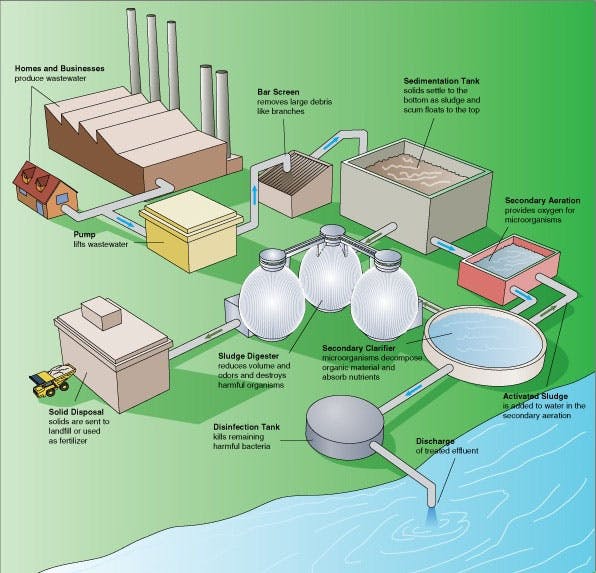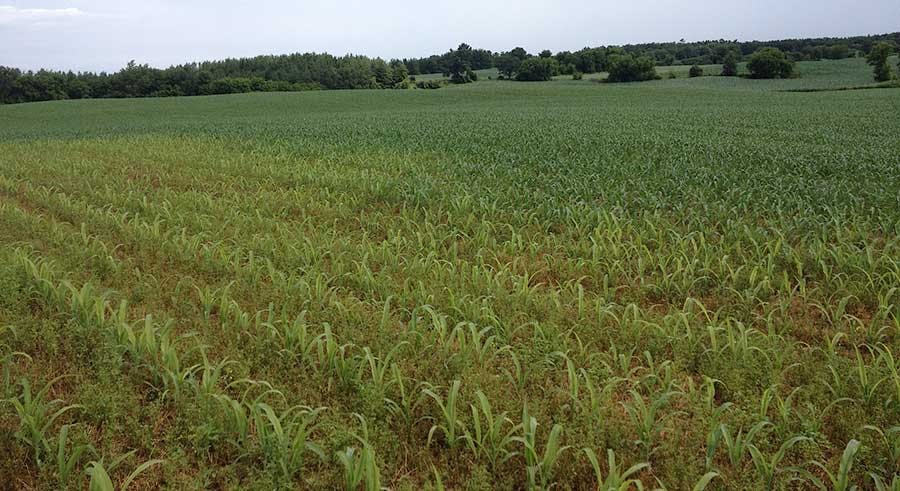Non Agricultural Source Material
Ministry of Environment and Climate Change
What are Biosolids?
Biosolids are nutrient-rich, processed organic material derived from wastewater treatment. They contain nitrogen, phosphorous, organic matter and micro-nutrients such a zinc, magnesium and copper, all of which are essential for crop growth.
Municipal wastewater treatment facilities separate the liquid and solid portions of wastewater. The solid portion undergoes biological treatment during which organic material is digested, or stabilized, by micro-organisms. Upon completion, biosolids must be analyzed for acceptability. This ensures that biosolids meet the quality standards, set by the Province of Ontario, and are suitable for land application.
Biosolids are a means to help municipalities reduce input, infrastructure and disposal costs, and to provide a cost effective way for farmers to meet the nutrient requirements for field crops.
For more information on the beneficial use of biosolids please follow the links below:
Or check out the following video:
How does sewage sludge become biosolids?
All sewage biosolids must be stabilized through a MoECC approved anaerobic or aerobic digestion process before being spread on agricultural land.
Digestion of the sludge provide stabilization reducing pathogen levels and breaking down organic matter into plant available nutrients.
Despite over 30 years of research which shows that, when conducted according to regulations, the land application of biosolids is safe, concerns remain over soil and groundwater contamination from trace elements, toxic chemicals and potentially harmful disease causing organisms (pathogens). To date, there have been no documented negative human cases where a biosolids program met all the provincial requirements. Finally, odors associated with the land application of biosolids are considered more of a nuisance than a health problem. Odours are often times the most objectionable aspect of biosolids use on neighbouring farms.

Why recycle biosolids onto agricultural land?
Using biosolids as a soil amendment closes the nutrient loop wherein harvested plants take nutrients from soil, humans obtain nutrients from the plants, and then we return nutrients to soil with biosolids. Biosolids are an endlessly renewable resource restoring carbon and nutrients to the land for the good of plants, and people.
Biosolids deliver a full suite of macro- and micronutrients, making them a superior source of plant food over synthetic fertilizers. Biosolids have a proven ability to improve soil structure thereby reducing runoff and erosion. Choosing to use biosolids as a soil amendment also reduces greenhouse gas emissions into the atmosphere.
Recycling biosolids onto agricultural land reduces the amount of material to go to landfill or incineration, but it also reduces the demand for commercial fertilizer required to grow a crop. Biosolids improve soil fertility, increase organic matter by enhancing soil structure and permeability, and reduce the potential for erosion.
Can any farm receive biosolids?
The short answer is no. Only farms that meet the criteria outlined in the Nutrient Management Act may receive biosolids. Criteria such as farming practices (crop rotation, nutrient application (manure, fertilizer), etc.), agronomic soil tests below 60ppm of phosphorous and above a pH of 6, slopes below 12% near surface water, municipal wells, residential wells, ground water and proximity to areas of commercial, community or institutional use must be accounted for in a field management plan. The Ontario Ministry of Agriculture, Food, and Rural Affairs will review the plan and provide an approval before biosolids can be applied.
Additional unregulated features like municipal wellhead protection areas or other environmentally sensitive areas must also be taken into consideration during the assessment.
If you would like to use biosolids on your farm please contact us and we will evaluate your farm to determine it’s suitability and the application methods that are appropriate for your location.
How much can be spread on a site?
The amount of biosolids that can be spread on a farm is governed by the Nutrient Management Act (NMA). Through extensive research, authorities have produced acceptable application limits for nitrogen, as well as 5 year application limits for phosphorus and heavy metals. All of these limits are outlined in the NMA. In general a farm site may receive biosolids to supply nutrients for that year's crop. Setbacks from environmentally sensitive features such as wells, creeks, high slopes etc. also effect the amount of biosolids that a field may receive.
Since no two fields are exactly the same, specific characteristics of a field must be looked at to determine a plan that will benefit the farmer and protect the environment. These characteristics, or factors, consist of soil type, slope, intended crop, nutrient requirements to grow the crop, nutrients applied by the farmer (i.e. manure, fertilizer), and available nutrients within the soil. Following the plan will ensure nutrient applications do no exceed the crop requirements, which could cause negative environmental impacts.
Using these factors, it may be possible to have multiple biosolids applications over a 5 year period.
When can biosolids be applied?
Biosolids cannot be applied unless an approved NASM plan (Non-Agricultural Source Material plan) has been obtained through the Ontario Ministry of Agriculture, Food and Rural Affairs (OMAFRA).
Once an approval is received, biosolids can be applied by licensed individuals from April 1st to November 30th, as long as the ground is not snow covered or frozen. The soil must be relatively dry and a crop is required to be established within one year of application. Generally, the spreading season occurs in the spring prior to planting, throughout the summer after the hay or sod has been harvested, and then in late summer through the fall after the fields (i.e. wheat, soybeans, etc) have been harvested. The Nutrient Management Act governs all field application requirements and outlines additional restrictions for each spreading season.
What crops have been fertilized with biosolids?
Crops that have been fertilized with biosolids are corn, hay, pasture, sod, wheat, soybeans, ornamental crops and trees. The NMA outlines pre-harvest waiting periods for sensitive crops, i.e. vegetables, tree fruits, etc., in order to protect human and animal health. Biosolids are not permitted for home gardening.
Is land application of biosolids an established practice?
Yes, Biosolids have been land applied in Ontario and Canada for well over 50 years with no documented health or environmental problems. However some counties have embraced it better than others. Australia, for example, has 81% of there treated sewage land applied as biosolids; Canada on the other hand, is currently using 33% of it’s sewage production as biosolids. However, the demand is growing as there is an increasing number of municipalities that see it as a cost effective and beneficial way to recycle their sewage.

Can I get more information?
Information on biosolids can be obtained throughout our website. If you have a specific question you cannot find an answer to please contact us at 1-866-493-7782 or email us.
For information on the legislation or best management practices check out the Ontario Ministry of Agriculture, Food, and Rural Affairs (OMAFRA) or call their nutrient management hotline at 1-866-242-4460.